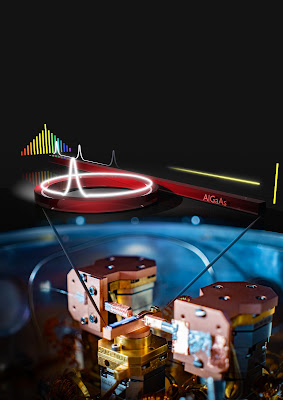Just as a meter stick with hundreds of tick marks can be used to measure distances with great precision, a device known as a laser frequency comb, with its hundreds of evenly spaced, sharply defined frequencies, can be used to measure the colors of light waves with great precision.
Small enough to fit on a chip, miniature versions of these combs — so named because their set of uniformly spaced frequencies resembles the teeth of a comb — are making possible a new generation of atomic clocks, a great increase in the number of signals traveling through optical fibers, and the ability to discern tiny frequency shifts in starlight that hint at the presence of unseen planets. The newest version of these chip-based “microcombs,” created by researchers at the National Institute of Standards and Technology (NIST) and the University of California at Santa Barbara (UCSB), is poised to further advance time and frequency measurements by improving and extending the capabilities of these tiny devices.
Paper: G. Moille, L. Chang, W. Xie, A. Rao, X. Lu, M. Davanco, J.E. Bowers and K. Srinivasan. Dissipative Kerr Solitons in a III-V Microresonator. Laser and Photonics Reviews. June 2020. DOI: 10.1002/lpor.202000022

Comments